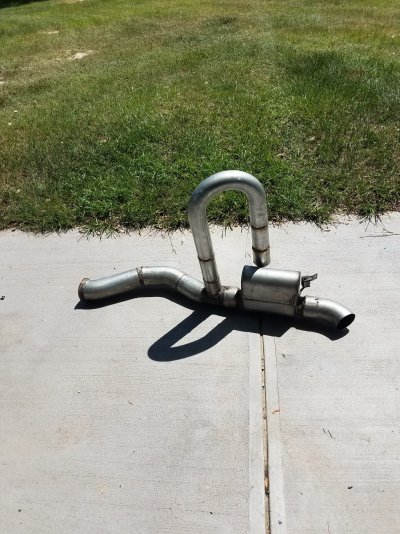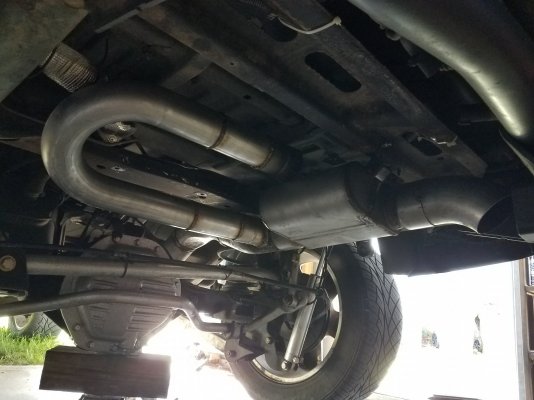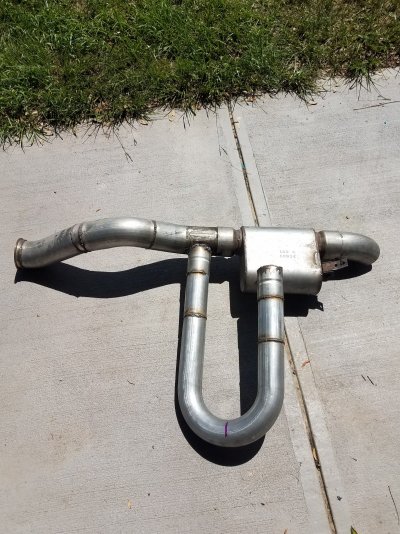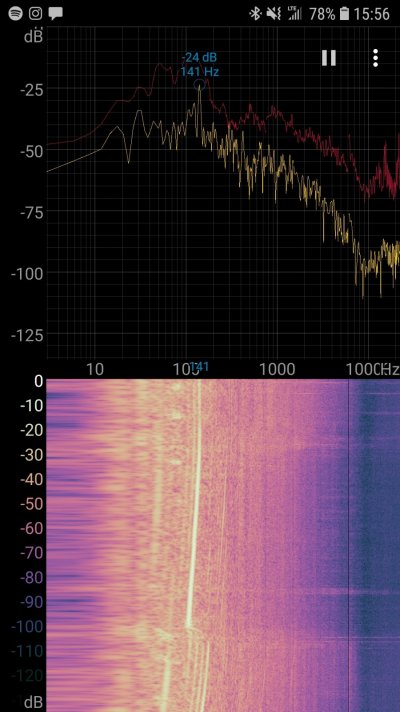My man, you know it. The .69 Krew ain't some suckahs lol.69 Krew dont back down!
You are using an out of date browser. It may not display this or other websites correctly.
You should upgrade or use an alternative browser.
You should upgrade or use an alternative browser.
2004 6.0 NV4500 Tahoe
- Thread starter Dantheman1540
- Start date
Disclaimer: Links on this page pointing to Amazon, eBay and other sites may include affiliate code. If you click them and make a purchase, we may earn a small commission.
iamdub
Full Access Member
It won't be that adjustable! I just happen to have some 3" couplers, so I am going to fish mouth one and weld it directly to the pipe that way I can simply clamp on my J tubes and see how they sound. That way I can make the long 42" and I think I will have enough left over for a 24-32" which is about what I'd need to target the 2,100 rpm drone. It will be fun to collect some data on this and prove this theory to myself. I also have room for an additional pipe down the side of the Gibson so I'm sorta preparing for the possibility of a second pipe.
@iamdub What do you think about adding a pipe to the side of a muffler? The Gibson is not much more than a box with some tubular louvered baffles that IMO don't do a whole lot. I think space-wise it would be cake to add some different length tubes down the side of it tight hugging the case. Just not sure if the turbulence from the louvers would disrupt the sound waves (Probably the whole point to the design) and cause the wave length calculation to be off or less effective.
Since the whole idea is to reflect a sound wave back onto itself (at least a "part" of it), focus on it more from a mechanical perspective. Two waves have to crash into each other, and a direct blow would be more effective than a glancing blow. Or, picture one car traveling on a highway being T-bóned by another car 1/4 the size. Now, picture that same 1/4-sized car NOT hitting it as a direct T-bone, but more of a glancing blow, almost a sideswipe. Which will be more effective at transferring energy? Now, to add in the baffles of the muffler: Picture two or more cars on the highway of various sizes (the main exhaust traveling through the system and muffler). How are you to determine what car would be 1/4 of the size of, well, multiple sized cars? At best, you could average the size of the cars and create a car 1/4 the size of that. But, the effectiveness of that one 1/4-sized car is spread among a few variously-sized cars so they all are less effected when it T-bones or even just grazes them.
The Gibson uses a bit of the Helmholtz effect by letting the sound waves escape through the holes where they collide with the remaining ones that course through the tubes and chambers.
You said the drone is strongest at 1,500 but comes back around 2,100. That's a 600 RPM difference. So, do you hear any remnants of it at 900 RPM? Keep in mind engine load plays a role in this. So, your throttle angle may reveal or hide the drone at various RPM. Being a wave produced by pulses, it should repeat in multiples (1,500 RPM, 3,000 RPM, 4,500 RPM, etc.). It'll change due to engine load (viewed as the density of the air through the pipe at a given RPM) and not purely just the frequency of those pulses.
Go for the kill and size your pipe for the worst of it and reassess.
Last edited:
Dantheman1540
Full Access Member
Since the whole idea is to reflect a sound wave back onto itself (at least a "part" of it), focus on it more from a mechanical perspective. Two waves have to crash into each other, and a direct blow would be more effective than a glancing blow. Or, picture one car traveling on a highway being T-***** by another car 1/4 the size. Now, picture that same 1/4-sized car NOT hitting it as a direct T-bone, but more of a glancing blow, almost a sideswipe. Which will be more effective at transferring energy? Now, to add in the baffles of the muffler: Picture two or more cars on the highway of various sizes (the main exhaust traveling through the system and muffler). How are you to determine what car would be 1/4 of the size of, well, multiple sized cars? At best, you could average the size of the cars and create a car 1/4 the size of that. But, the effectiveness of that one 1/4-sized car is spread among a few variously-sized cars so they all are less effected when it T-bones or even just grazes them.
The Gibson uses a bit of the Helmholtz effect by letting the sound waves escape through the holes where they collide with the remaining ones that course through the tubes and chambers.
You said the drone is strongest at 1,500 but comes back around 2,100. That's a 600 RPM difference. So, do you hear any remnants of it at 900 RPM? Keep in mind engine load plays a role in this. So, your throttle angle may reveal or hide the drone at various RPM. Being a wave produced by pulses, it should repeat in multiples (1,500 RPM, 3,000 RPM, 4,500 RPM, etc.). It'll change due to engine load (viewed as the density of the air through the pipe at a given RPM) and not purely just the frequency of those pulses.
Go for the kill and size your pipe for the worst of it and reassess.
That is pretty much exactly what I suspected and I really enjoyed the analogy. Should have the J tube done sometime tomorrow

iamdub
Full Access Member
That is pretty much exactly what I suspected and I really enjoyed the analogy. Should have the J tube done sometime tomorrow
Yeah, demolition derby on a public highway always gets the point across!
Anxious for the results!
Hell yeah! Free is a very good price!Oh boy just dropped the truck off at discount tire for the screw removal and apparently, there is a plug right next to it and might cause the tire to be trashed. Good thing I got that warranty because they will replace it Fo-Free!
pwtr02ss
Full Access Member
You know, you're a pretty fart smeller when you start getting all technical and what not.Since the whole idea is to reflect a sound wave back onto itself (at least a "part" of it), focus on it more from a mechanical perspective. Two waves have to crash into each other, and a direct blow would be more effective than a glancing blow. Or, picture one car traveling on a highway being T-bóned by another car 1/4 the size. Now, picture that same 1/4-sized car NOT hitting it as a direct T-bone, but more of a glancing blow, almost a sideswipe. Which will be more effective at transferring energy? Now, to add in the baffles of the muffler: Picture two or more cars on the highway of various sizes (the main exhaust traveling through the system and muffler). How are you to determine what car would be 1/4 of the size of, well, multiple sized cars? At best, you could average the size of the cars and create a car 1/4 the size of that. But, the effectiveness of that one 1/4-sized car is spread among a few variously-sized cars so they all are less effected when it T-bones or even just grazes them.
The Gibson uses a bit of the Helmholtz effect by letting the sound waves escape through the holes where they collide with the remaining ones that course through the tubes and chambers.
You said the drone is strongest at 1,500 but comes back around 2,100. That's a 600 RPM difference. So, do you hear any remnants of it at 900 RPM? Keep in mind engine load plays a role in this. So, your throttle angle may reveal or hide the drone at various RPM. Being a wave produced by pulses, it should repeat in multiples (1,500 RPM, 3,000 RPM, 4,500 RPM, etc.). It'll change due to engine load (viewed as the density of the air through the pipe at a given RPM) and not purely just the frequency of those pulses.
Go for the kill and size your pipe for the worst of it and reassess.
thanks for explaining that in a way I can understand wtf that double d*ick does in the muffler department
iamdub
Full Access Member
You know, you're a pretty fart smeller when you start getting all technical and what not.
thanks for explaining that in a way I can understand wtf that double d*ick does in the muffler department
I'm only relevant in so few areas in this world, so I appreciate the opportunity to geek out!
I'm only relevant in so few areas in this world, so I appreciate the opportunity to geek out!


Dantheman1540
Full Access Member
This 1/4 wave resonator mumbo jumbo works dawg! Like for realz I'm surprised how quiet it was. I first started it on jack stands with just the back half of the truck in the shop and thought "wow this is quiet but, it must be because the front half is outside the garage still" went for a ride and it has eliminated nearly all the drone at 1,500 rpm like I wanted. Its so good it made ththe 2,100 rpm drone noticable but that's ok because the requires a much shorter pipe if, I do anything about it at all.
Attachments
iamdub
Full Access Member
This 1/4 wave resonator mumbo jumbo works dawg! Like for realz I'm surprised how quiet it was. I first started it on jack stands with just the back half of the truck in the shop and thought "wow this is quiet but, it must be because the front half is outside the garage still" went for a ride and it has eliminated nearly all the drone at 1,500 rpm like I wanted. Its so good it made ththe 2,100 rpm drone noticable but that's ok because the requires a much shorter pipe if, I do anything about it at all.
Do you have any sections of your exhaust that are relatively long and straight, like parallel to the driveshaft, in front of the axle? Most J-pipes come off the main pipe and immediately turn 90° and run parallel to the pipe. Makes for a much tighter package and less turns. Turns alter the tuning frequency since the wave is slowed and slightly altered with every degree of turn.




